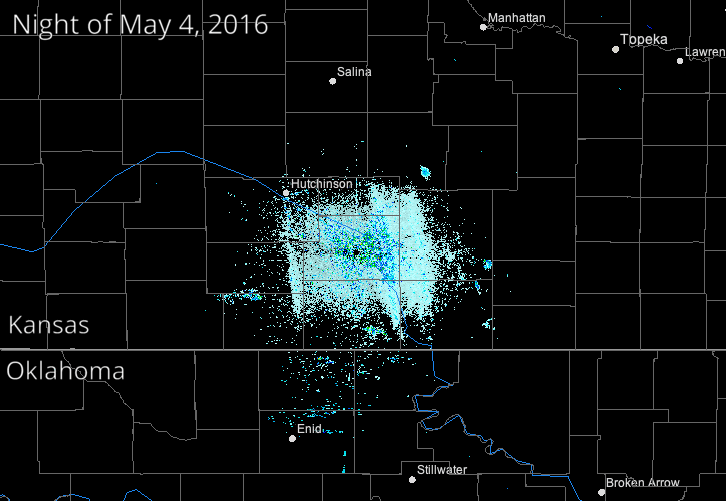Billions of birds migrate through the United States every spring and fall. Just-right conditions make the journey safer. Tailwinds are helpful, for example. Low cloud cover keeps the stars visible. And it’s best to avoid mass ejections of magnetized plasma from the Sun.
Space weather such as solar winds and solar flares can interfere with Earth’s magnetic field, which birds use to navigate. Between 9% and 17% fewer birds migrate during severe space weather events, according to a new study. And in some cases, birds that did migrate had more difficulty navigating.
The findings are timely, as the Sun is entering the peak of its 11-year cycle of activity. A lot of space weather makes for excellent atmospheric lights shows but could spell trouble for migrators.
Feathers and Weather
The Sun is constantly firing charged particles into space. Earth’s magnetic field repels most of this radiation, but severe solar storms are strong enough to pierce Earth’s magnetosphere, affecting electrical systems below. A series of solar storms in 1989, for example, collapsed Quebec’s power grid, stalled stock markets in Toronto, and brought the northern lights as far south as Cuba.
These severe storms can also affect birds. Scientists have studied the connection between avian migration and Earth’s magnetic field since at least the early 1970s, but most studies have been short-term or focused on a few lab-based individuals, said Eric Gulson-Castillo, a doctoral student in ornithology at the University of Michigan and lead author on the new research. He and his colleagues examined 23 years of geomagnetic disturbances and millions of wild birds.
The researchers used Doppler radar to get migration numbers. Transmitters send a radio wave into the atmosphere, and a receiver detects a return wave after it bounces off an object. Meteorologists, who use this type of data to create weather forecasts, filter out birds and insects. “Ornithologists can do the opposite,” said Ben Winger, an evolutionary biologist at the University of Michigan and study coauthor. The stronger the return signal is, the greater the number of birds present is. The team focused on the flat prairie states, avoiding birds’ navigational aids such as coastlines and mountains to isolate how they are affected by Earth’s magnetic field. The team also controlled for the effects of atmospheric weather.

The researchers tracked hourly shifts in magnetic disturbance at stations from Panama to Canada. Large deviations from the expected daily variance occurred when solar winds and storms were hammering Earth. Most birds migrate at night, so the researchers isolated nights of intense space weather, when the geomagnetic disturbance exceeded 500 nanoteslas. That’s generally a good threshold to detect disturbance, said Luis Navarro, a space weather researcher at the University of Colorado Boulder who was not involved in the study. One solar storm can disrupt Earth’s magnetic field by 2,000 nanoteslas or more, he added. Roughly 3% of the nights included in the study exceeded the 500-nanotesla threshold.
During these intense episodes of space weather, fewer birds migrated.
During these intense episodes of space weather, fewer birds migrated. That was true even when atmospheric weather factors, such as air pressure, wind speed, humidity, and temperature, were otherwise favorable for migration. Earth weather is the primary driver for pulses of migration, and the data show that space weather also plays a role, Gulson-Castillo said. Solar blasts that slam into Earth’s magnetic field can muddy the navigational cues for migrating birds, reducing the number of migrators. The new study shows the effects not just on a few individual birds, but across a population. The group published their results in the Proceedings of the National Academy of Sciences of the United States of America.
The models also noted that birds in flight during geomagnetic disturbances were less likely to fight against the wind, at least under certain conditions. Birds were likelier to drift off course in the fall, possibly because there were more first-time migrators joining the flock and less motivation to reach nesting sites compared to the spring. Increased drift provides more evidence that solar storms alter a bird’s ability to navigate using geomagnetic cues.
The study is unique and interesting, Navarro said, and it’s nice to see another side of space weather’s earthbound effects. Most discussion in the field focuses on the consequences of space weather to industry and military interests, not to biology. But, he noted, the paper only identifies an interesting correlation at this point, and “space weather is a very complex dynamic system.”

More Than Meets the Human Eye
Though there’s not much Earth denizens can do about space weather, the study still aids conservation efforts. Ornithologists already predict mass migration events on the basis of atmospheric weather. Incorporating space weather could enhance the prediction tool kit, Winger said. Conservationists use those migration forecasts to pressure cities to minimize light pollution, which can distract and confuse migrating birds.
“Whether it’s space weather or whether it’s local weather, we want to understand why birds do what they do.”
“Whether it’s space weather or whether it’s local weather, we want to understand why birds do what they do,” said Andrew Farnsworth, a migration ecologist at the Cornell Lab of Ornithology, who reviewed a draft of the publication but was not involved in the research. “This is another really important bit of information,” he said of the study. Unlike lab-based research, the authors explored geomagnetic disturbances in relation to millions of birds, used a creative approach to radar, and found a detectable pattern, he noted. The result “opens up a really interesting avenue for thinking beyond the individual [bird].”
Ultimately, the migration study sheds light on environmental cues that humans can’t directly perceive. This behavior is nothing new, just our awareness of it, Gulson-Castillo said. “The Sun has always been there and has always been doing this, as long as birds have been here.”
—J. Besl (@J_Besl), Science Writer

